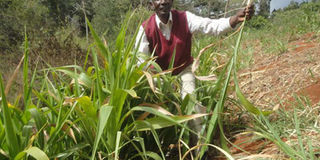With guatemala, I find the grass always greener

Evans Mwangi in his farm in Nyeri where he grows Guatemala Grass. The grass is cultivated primarily for fodder in cut-and-carry systems and can also be used to make silage. PHOTO | JOSEPH WANGUI | NATION MEDIA GROUP
What you need to know:
- The grass, whose origin is India, has higher concentration of crude proteins of 12 per cent compared to normal grass.
- The grass is drought resistant, thus is regarded as a saviour during dry spells and also withstands napier grass stunt and head smut diseases.
- Guatemala grass is cultivated primarily for fodder in cut-and-carry systems and can also be used to make silage.
- He further uses the grass to conserve soil on his sloppy land preventing erosion.
Evans Mwangi, 62, smiles as he tours his acre-and-a-half of fodder grass in Tambaya village in Mukurweini, Nyeri County.
The former police officer who served in the service from 1975 to 1982 before quitting grows the grass named Guatemala for sale.
Mwangi says he ventured into the farming to supplement his income in 2000 after he was given eight root splits by a friend who worked at Egerton University.
The father of six now specialises on propagation of planting materials, which he has planted on one-and-half acres neighbouring Gikira River.
The grass, whose origin is India, has higher concentration of crude proteins of 12 per cent compared to normal grass.
“I plant stem cuttings with a length of 20-30cm or rooted culms (root splits) either in holes or in a plough furrow and within three to four months, they mature and are ready for harvesting. Its maximum height is about seven feet,” says Mwangi, who focuses on selling root splits to farmers.
He sells a bundle of six root splits at Sh100, mainly during farmers’ field days and agricultural shows earning some Sh50,000 in a good event.
“I have sold splits to farmers from all parts of the country and also from Uganda. I keep a calendar of agricultural shows because that is where I make more money,” he says.
The grass is drought resistant, thus is regarded as a saviour during dry spells and also withstands napier grass stunt and head smut diseases.
BOOSTS MILK PRODUCTION
Guatemala grass is cultivated primarily for fodder in cut-and-carry systems and can also be used to make silage.
Mwangi says when harvested for direct feeding in cut-and-carry method, fresh grass should be left to wilt for about 12 hours under shade before being chopped and fed to animals.
The grass helps to increase milk production, according to a research by the Kenya Agricultural and Livestock Research Organisation (Kalro).
However, Kalro field assistant Henry Rotich notes that it is not recommended to feed the animals the grass directly as it will leave a smell on the milk.
“We advise the farmers to ferment it for a week before feeding the animals as this will help kill the smell in the milk.”
A well-managed Guatemala grass produces 5-7 tonnes of dry matter per acre in a year, which is said to be enough to feed a dairy cow in one year.
The farmer, who also owns three dairy cows, uses the grass to feed the animals, which all produce about 45 litres of milk daily.
He is a member of Gakindu Dairy Cooperative Society which buys a litre of milk at Sh30.
He further uses the grass to conserve soil on his sloppy land preventing erosion.
“This grass is a good soil binder and an organic matter builder. The leafy grass is also rich in crude fibre, carbohydrate and protein. Its quality is constant and yields in an animal are also high and constant,” John Kang’ara, a livestock health expert based in Embu.





